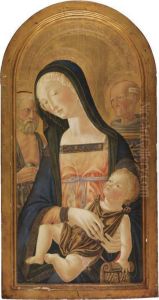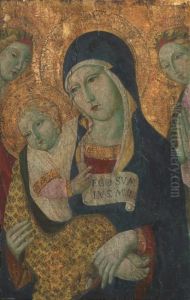Icilio Federico Joni Paintings
Icilio Federico Joni was an Italian painter born on October 27, 1866, in Castiglione d'Orcia, Tuscany. He is best known for his work in the style of the Sienese school, particularly his expertise in creating imitations of medieval art—a practice that became quite prominent in the late 19th and early 20th centuries among collectors and connoisseurs.
Joni's initial training was under his father, a decorator and restorer, which gave him a strong foundation in traditional painting techniques. This early exposure to the restoration of ancient artworks greatly influenced his later work. Joni was also influenced by the Sienese Gothic style, which had a profound impact on his artistic development.
During his career, Joni became famous for his ability to mimic the style of old masters, and he produced numerous 'forgeries' that were often sold as genuine medieval pieces. These works were so convincing that several ended up in prestigious collections and museums before their true nature was discovered. Despite this dubious aspect of his career, Joni's work was also appreciated for its artistic merit, and he was recognized as a talented painter in his own right.
In addition to painting, Joni was also involved in the local artistic community in Siena. He was a member of the Academy of Fine Arts and took part in various exhibitions, including the Mostra dell'Antica Arte Senese in 1904, which celebrated the Sienese artistic tradition. His work thus played a part in the revival of interest in the Sienese school during the late 19th and early 20th centuries.
Icilio Federico Joni's career was a complex mix of genuine artistic production and the creation of works that catered to the art market's demand for Renaissance and medieval pieces. His legacy is somewhat marred by his involvement in art forgery, but he remains a significant figure in understanding the art market and the revival of historic art styles during his time.
Joni passed away in 1946, leaving behind a body of work that continues to be studied for its technical skill and historical significance, as well as for the insights it provides into the world of art forgery and the antique art market of the late 19th and early 20th centuries.

